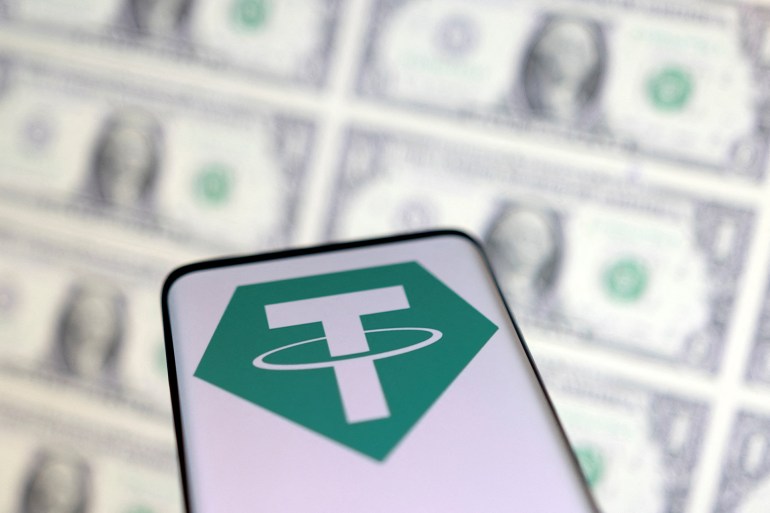Last week, the $1.3 trillion cryptocurrency industry faced one of its toughest challenges when the stablecoin Tether - an important number in the market - failed to maintain its peg to the US dollar.
The British Financial Times reported that Tether fell to 95.11 cents in European trading, well below the one-dollar price it seeks to maintain.
Its price later recovered, but a rare slide days after the failure of smaller competitor TerraUSD sent Bitcoin - the world's largest digital asset - to its lowest level since late 2020.
Rating group Fitch said the problems with Tether and TerraUSD highlight the fragile nature of private stablecoins and will accelerate calls for regulation.
Testifying before Congress, US Treasury Secretary Janet Yellen said that the collapse of "TerraUSD" showed the risks of stable currencies, which the administration of US President Joe Biden and US regulators have become increasingly concerned about.
"I wouldn't describe it on this scale as a real threat to financial stability, but it is growing very rapidly and presents the same kind of risk that we have known for centuries in terms of bank operations," Yellen told lawmakers.
The stablecoin Tether failed to maintain its peg to the US dollar (Reuters)
Threat to the stability of digital currencies
Stablecoins, which are supposed to track real-world currencies, play a central role in the stability of the broader cryptocurrency market by providing traders with a safe place to park their money between making bets on volatile digital currencies.
Tether, the largest operator in this $180 billion stablecoin space, plays an important role in facilitating trading through the cryptocurrency market and also provides a link with the mainstream financial system.
Rating group Fitch said the problems with Tether and TerraUSD highlight the fragile nature of private stablecoins, and will accelerate calls for regulation.
Tether aims to maintain its peg to the dollar by holding a stockpile of traditional asset reserves, and there are 80 billion Tether tokens in circulation, meaning that the currency’s stock must contain $80 billion in assets, an amount comparable to the world’s largest hedge funds, but details about How to manage these reserves is scarce, and is not subject to audits under internationally recognized accounting standards.
Paolo Arduino, chief technology officer of Tether, vowed to defend the token's dollar peg, and said the company had bought "a ton" of US government debt, which it would like to get rid of in this effort, but in an interview with the Financial Times, he declined to give details of The $40 billion stockpile of US government bonds because he didn't want to reveal our "secret sauce".
Last year, the US Commodity Futures Trading Commission fined Tether $41 million, claiming the company had made "incorrect or misleading" statements about its reserves.
Arduino also said that the stablecoin issuer is working to get an audit, but said that major accounting firms are “very afraid of the reputational risk of touching cryptocurrency at this moment.”
Arduino added that Tether received $2 billion in redemption requests the day before its collapse, an unusually high number.
He said that the group had recently shifted from holdings of commercial paper (a type of short-term corporate debt usually sold by highly rated companies) to treasury bonds, adding that treasury bills now represent about half of the group's $80 billion reserves.
stable cryptocurrency
Stable digital currencies are an essential part of the world of digital currencies, and are theoretically characterized by their ability to protect traders and investors from market fluctuations and have a value linked to the US dollar or any other paper currency, and this helps reduce fluctuations and convert them into digital funds that are easily transferable from one exchange to another.
Stable currencies differ from other cryptocurrencies such as Bitcoin in that they are stable in value, while the second is highly volatile, as it represents a bridge between real fiat currencies and cryptocurrencies.
According to a report by the Modern Diplomacy website, there are two main types of stablecoins: centralized and decentralized stablecoins.
Central stablecoin
This type of stablecoin is usually linked to fiat currencies that are secured off-chain and linked to a third party such as a bank. The best examples of centralized stablecoins are Tether (USDT) and Coinbase (USDC), as well as some new additions To the currency market such as "TUSD", "PAX", "BUSD" and "GUSD".
These currencies are centralized because they are released or controlled by a central organization which can be either a company, a bank, or even a government.
This type of digital currency is basically a tokenized debt security that is published and traded on a “blockchain” system such as “Ethereum”, and works to achieve a balance between supply and demand through minting and redemption mechanisms.
Under this model, users can mint stablecoins by depositing traditional equivalents to a custodian, redeeming or burning tokens to get fiat back.
Among the top 3 centralized stablecoins are the Theater (USDT), the TrueUSD which was launched in 2018, and the Gemini Dollar GUSD.
Decentralized stablecoins
Decentralized stablecoins are fully transparent currencies that no one can control (digital currencies without a central operator or controller unlike centralized stablecoins) and the collateral support in them is visible to everyone because the funds are on a publicly verified blockchain system.
Decentralized stablecoins can be divided into two parts: secured cryptocurrencies and algorithmic ones.
Among the top 3 decentralized stablecoins are the DAI token, which was created and stabilized by using an Ethereum-based coin deposited in MakerDAO vaults, followed by EOSDT. (EOSDT), a well-known cryptocurrency running on the EOS platform, and the “Divy Dollar” (DUSD) coin that gives investors an opportunity to collect different stablecoins in its single token and protects users from any potential risks.

